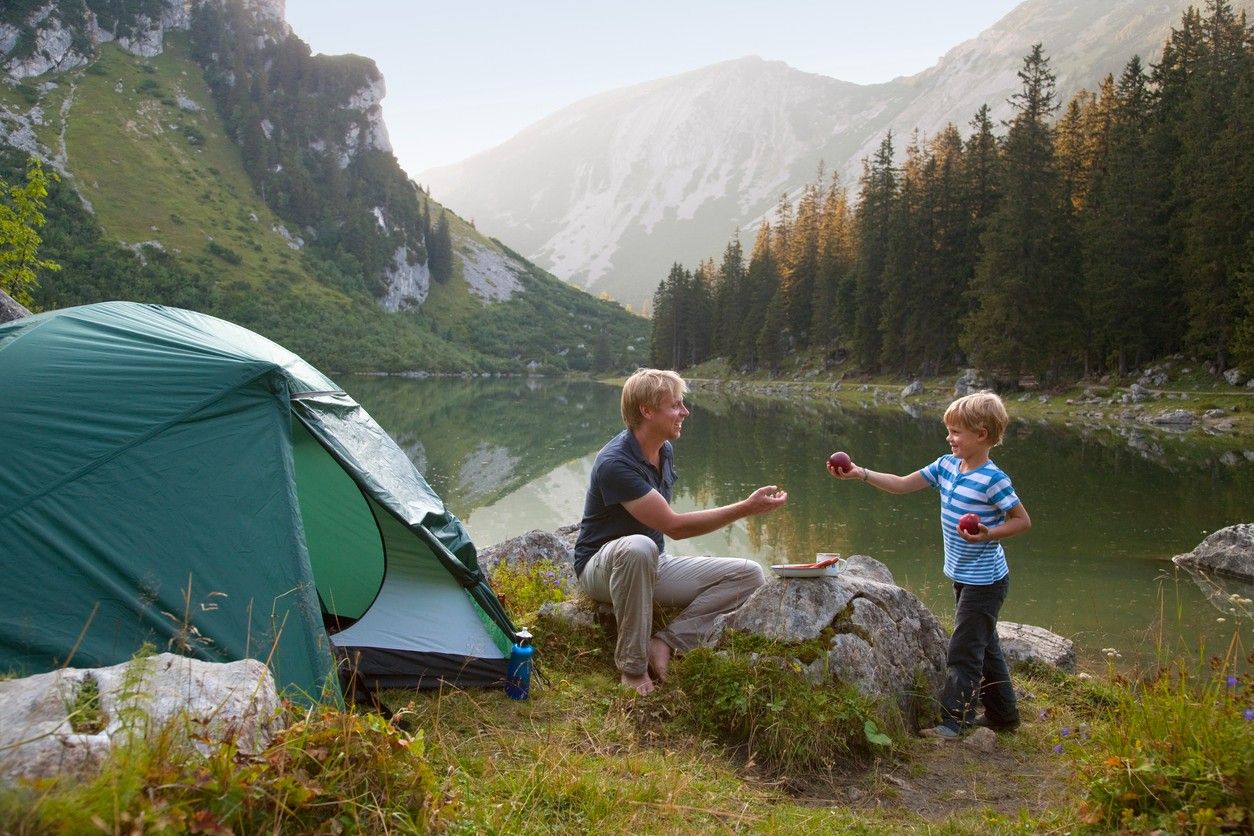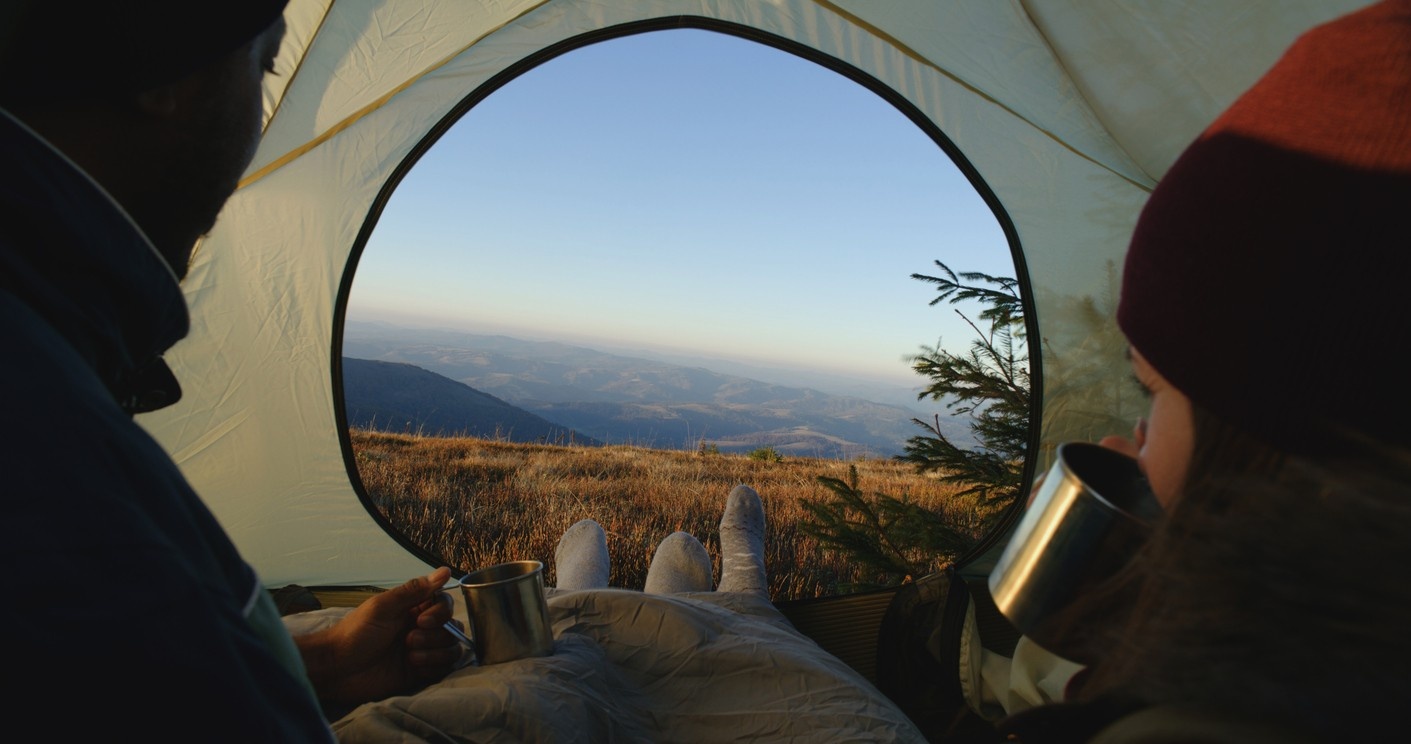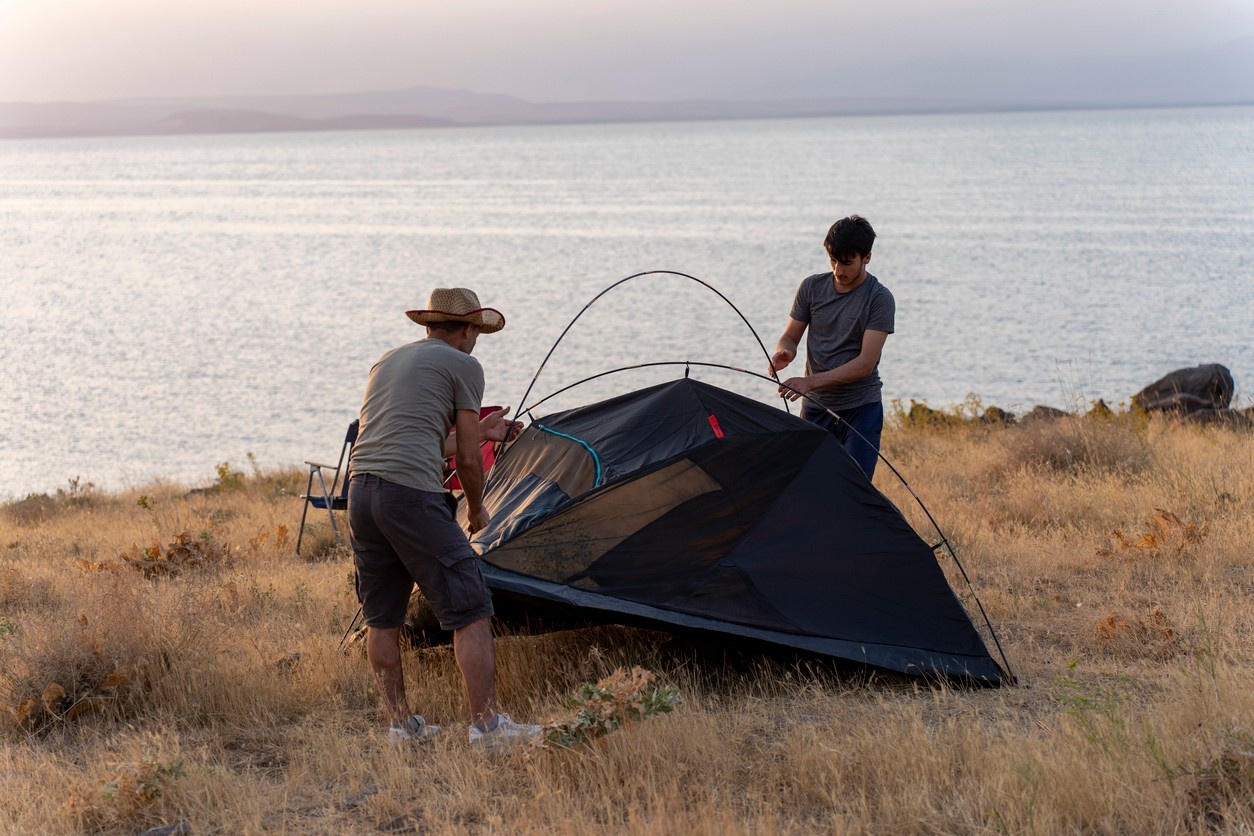What are Hiking Tents?
A hiking tent is a portable shelter designed specifically for backpacking trips and multi-day treks into the wilderness. These tents provide overnight accommodation along the trail and aim to balance weather protection, livability, and minimal weight. Hiking tents come in a range of capacities from ultralight 1-person models to more spacious 3-4-person options. But they share some common traits that differentiate them from larger family camping tents used at drive-up campsites. Key features of a hiking tent include ultralight fabrics like ripstop nylon to minimise packed weight. Many use breathable mesh for ventilation. Hiking tents have a compact take-down size of around 5 by 20 inches when stored in a sack. They allow quick and easy assembly using shock-corded poles and colour-coded clip connections. Hiking tents have waterproof and moisture-wicking "bathtub" style floors. Some use removable ground sheets for further protection. They utilise rainfly covers made of coated ripstop nylon to shield them from precipitation. Multiple vents and mesh walls promote airflow to minimise condensation. Durable yet flexible poles made of lightweight aluminium or carbon fibre are used. Hiking tents have interior gear loops, pockets and lantern hooks for organising equipment. They feature reinforced stitching on high-stress points for durability and longevity.
What to Look for in a Hiking Tent
When choosing a tent for hiking, there are several key factors to consider:
Weight
When selecting a backpacking tent, weight is a critical consideration. Ultralight hiking tents that weigh less than 3 pounds offer protection from the elements while remaining highly portable for extended trips. Heavier tents ranging from 5-7 pounds provide more durability and interior space but are more suited for shorter hikes and base camping. It's important to factor in the total weight of the entire system including the tent body, poles, stakes and storage bags when evaluating overall heft. Advanced ultra-lightweight tents utilise innovative materials like lightweight ripstop nylon, carbon fibre poles, and Dyneema composite fabrics to pare down grams without sacrificing structural integrity. For multi-day thru-hikes where every ounce counts, ultralight tent weights under 2 pounds are ideal to maximise mileage with minimal fatigue. For weekend warriors and recreational camping, tents in the 4-5 pound range offer a nice balance of packability and liveable space. As a general rule, focus your search on tents falling in the 1-5 pound packed weight range depending on intended distances and your fitness level.
Packed Size
Given limited backpack space when trekking miles into the wilderness, a tent's packed size is an important logistical consideration. Premium tents for hiking from reputable brands are engineered to pack down surprisingly small into an integrated storage sack or compression stuff sack. Look for tents with compact hubbed pole systems, thin yet rip-resistant canopy and rainfly fabrics, and minimal excess hardware to maximise compactness. The latest designs offer excellent weather protection and interior space rivalling larger tents while packing down to a tight bundle a little larger than a Nalgene bottle. A packed size of 5 by 20 inches or less will take up minimal room in your pack. It's helpful to unpack the tent in-store and practice packing it down to its smallest size to get a feel for how condensed it can get. While ultra-compact packing is ideal, be sure to balance capacity and liveability as well. With today's materials and ingenious designs, backpacking tents can offer the best of both worlds.
Weather Protection
The primary purpose of a hiking tent is to provide reliable protection from the elements, including rain, wind, changing temperatures, and even snow at higher altitudes. When researching tents, look for models that use high denier, rip-stop polyester or nylon for maximum water repellency. Many premium tents are coated with a durable water-resistant finish to further seal moisture out of vulnerable seams and fabric pores. Fully taped interior seams are key for preventing drips during downpours and storms. For wind resistance, aim for flexible yet sturdy poles of aluminium or carbon fibre, along with reinforced guy lines and tie-down points to add stability in gusty conditions. For use in colder temperatures, opt for a 4-season tent with steep side walls and extended fly configuration to ensure snow and frost stay out of the living space and off the roof. Carefully vet the tent's fabric denier rating, seam construction method, and pole quality to gauge its resilience in harsh conditions. With the right model, you'll stay cosy inside your tent when the weather turns nasty outside.
Doors and Vestibules
For livability and useability, hiking tents typically have at least one door for easy access along with a vestibule or extended fly for protected storage space. Doors allow hassle-free entry and exit without lots of crawling, while vestibules enable you to stash muddy boots and wet gear outside the main tent floor. Look for tents with two doors and vestibules for even more versatility. On rainy days or during bug seasons, you can cook or hang out in the vestibule area without cramming into the tent interior with the whole crew. High-end models will include oversized rainfly vestibules to truly maximise livable space and covered storage. When shopping, prioritise tents offering vestibules sized to provide adequate protection based on the interior capacity and your intended group size.
Livability
For livability and useability, hiking tents typically have at least one door for easy access along with a vestibule or extended fly for protected storage space. Doors allow hassle-free entry and exit without lots of crawling, while vestibules enable you to stash muddy boots and wet gear outside the main tent floor. Look for tents with two doors and vestibules for even more versatility. On rainy days or during bug seasons, you can cook or hang out in the vestibule area without cramming into the tent interior with the whole crew. High-end models will include oversized rainfly vestibules to truly maximise livable space and covered storage. When shopping, prioritise tents offering vestibules sized to provide adequate protection based on the interior capacity and your intended group size.
Ease of Setup
After a long day hiking with a heavy pack, the last thing you want is a complex tent setup process after arriving at camp. The best tent for hiking are engineered for quick, intuitive pitching using shock-corded poles and straightforward clip-in designs. Look for colour coding on the poles, clips and fabric to ensure fast matching of corresponding points. Practice setup at home to get set up smoothly in just a few minutes. Other ease-of-use aspects to look for include pole hubs and geometries that nearly assemble themselves, Jake's feet or other stand-alone pole corner systems, and creative slip-through fisheye-type grommets for hassle-free threading. Freestanding tents provide the flexibility to move locations without re-staking every time as well. While assembly time depends on the size of the tent, innovative design and hub systems allow even 4-person tents to pop up almost instantly after site selection.
Durability and Materials
Hiking tents must stand up to considerable wear and tear on the trail, including long-term UV exposure, rain events, wind stress, and friction from packing. Look for tents that use quality lightweight yet rugged materials to provide durability without adding excess ounces. Premium ultra-light nylons and polyesters are coated with protective finishes to increase lifespan and water repellency over years of use. Aluminium poles are trusted standbys that resist corrosion and provide strength at low weights. Fiberglass poles add beneficial flex. Sturdy yet lightweight clip systems outlast flimsy plastic joints, and oversized zippers hold up much longer as well. Pay attention to denier ratings on the floor and fly - the higher the number, the tougher and more abrasion-resistant the fabric. Well-constructed tents designed and built to last 5+ years in the field will reward you with years of trips to come.
Types of Tents for Hiking
Hiking tents fall into a few main categories based on capacity, seasonality and weight.
Capacity
- Solo tents are lightweight, compact person shelters ideal for thru-hikers and minimalist camping. Interiors are snug.
- 2-person tents offer interior space for two plus gear storage. Most versatile size for couples or solo hikers.
- 3-4-person tents are bigger and heavier but allow for camping with several people. Useful for base camping.
Season Rating
- 3 season tents are built to handle spring, summer and fall weather. Well-ventilated and lighter in weight.
- 4 season tents are built to handle harsh winter conditions with stronger frames, more durable materials and steep walls to shed snow.
- Extended season tents bridge the gap between 3 and 4-season designs for added versatility.
Weight
- Light hiking tents focus on keeping weight to a bare minimum, usually under 3 pounds. Smaller interiors and more compact when packed.
- Lightweight hiking tents offer excellent weight savings without sacrificing livability. Range from 3-5 pounds.
- Expedition tents prioritise maximum durability and liveability over weight savings, 5 pounds and up.
Now let's take a look at some of the top hiking tent models in different categories and capacities.
Best Lightweight Backpacking Tents for 1-2 People
When tackling trails for overnight trips or weekends in the backcountry, you need a sturdy yet portable tent designed for two people or cosy solo use. These lightweight backpacking tents offer an excellent blend of weather protection, space and ease of carrying. Look for models ranging from 1-3 kg packed weight. Here are some top choices from reputable British brands:
Vango Helvellyn 200 Tent
The Vango Helvellyn 200 tent is a lightweight yet rugged choice that's designed for easy pitching and reliable weather protection, weighing in at just 2.4kg. Perfect for backpacking adventures, this versatile tent stands up to tough UK conditions while remaining portable for hassle-free carrying. Its endurance in wind and rain is thanks to Vango’s trusted TBS® II Tension Band System, which braces the tunnel structure for steadfast stability in bad weather. Pre-angled poles enhance headroom and internal space, and the straightforward clip-in system ensures quick setup after a long day on the move.
The Helvellyn 200 features StormShield technology, providing fully taped seams and a 70D ProTex® Shield flysheet with a 3,000mm hydrostatic head for excellent waterproofing. Adjustable venting keeps condensation under control and maintains airflow even during rainy nights. The tent’s spacious front porch offers ample covered space for muddy boots and rucksacks, while dual access allows easy entry and exit regardless of wind direction. Inside, there’s a comfortable sleeping area for two people, offering sufficient room for restful nights. Handy internal pockets and hanging loops let you organise gear, and reflective guylines enhance nighttime visibility.
Weighing only 2.4kg, the Helvellyn 200 won’t overload your pack, making it ideal for extended treks. Its tough weather protection and smart storage features make this tent an excellent choice for multi-day hiking trips in unpredictable British weather, offering great value and the perfect blend of lightweight portability and robust performance.
The MSR Elixir 2 Backpacking Tent
The MSR Elixir 2 backpacking tent is built to handle whatever weather the trails may bring while keeping total weight to just over 2 kg. This 3-season tent utilises an innovative Airflow 2 tent body to maximise interior space and create a cavernous feel that belies its ultralight-packed size. The Elixir 2 tent body suspends the inner walls between two crossed poles, opening up a livable room and enhancing airflow. The vertical side walls and high peak height allow two occupants to sit up fully and move around inside the tent without crouching. Two generous D-shaped doors make entry and exit a breeze while providing flexibility in opening just one or both sides as needed. The rain fly provides 360-degree coverage with an extended vestibule area for protected storage of packs, boots, and wet outer layers outside the mesh inner tent. Factory-sealed seams, adjustable venting, and durable 70D 185T polyester fabrics make the Elixir 2 well-prepared to handle rainy and windy conditions on the trail. Despite its robust weather protection and fully freestanding design, the Elixir 2 tent weighs just 2.2 kg. Easy to pitch in minutes, the innovative cross-pole architecture and colour-coded clips allow swift assembly after a long day of hiking. MSR's expertise brings an excellent balance of minimal packed weight while retaining uncompromising liveability. The cavernous interior and vestibule have plenty of room for two occupants plus gear for weekends or longer escapes.
Best Expedition Tents for Comfort on Extended Trips
When embarking on camping holidays lasting several days or weeks, larger expedition tents provide extra interior space to unpack and get comfy. Their cavernous dimensions and heavy-duty construction ensure you stay happy and well-protected no matter the conditions. Here are some top spacious options:
Coleman Meadowood 4L Blackout Tent
The Coleman Meadowood 4L Blackout Tent provides ample sleeping and storage space in a robust design built to block out early morning sunlight so you can sleep in. With room for 4 campers and generous head height, this tent creates a comfortable mobile bedroom ideal for weekends away with the family or friends. The Meadowood 4 tent uses Coleman’s BlackOut Bedrooms which seamlessly integrate ultra-dark fabrics into the rear sleeping area. This blocks 100% of external light for post-sunrise slumbering when normal tents turn bright and hot. Two roomy bedrooms promote privacy and minimise midnight disturbances from tentmates. The living area offers ample floor space for relaxing, playing games and storing luggage and gear. A heavy-duty polyethene groundsheet keeps floor moisture at bay, while the polyester outer stands up to rain and wind gusts. Two large PVC windows provide views out and ventilation. Assembling the structure is quick and straightforward using the pre-attached poles and InstaClip system. Weighing in at 10.2 kg, the Meadowood 4L tent provides a cosy home away from home for longer camping trips with its blacked-out sleeping area, fully sealed seams, ample headroom of 196 cm, and spacious interior for four. Easy to transport and set up for a comfortable night's sleep.
Outwell Sky 6 Tent
The Outwell Sky 6 tent is a spacious, family-focused tunnel tent that combines generous living areas with comfort-driven design and outstanding practicality. Tailored for up to six campers, it features three darkened Premier Bedrooms to promote restful sleep by minimising early-morning light and enhancing privacy, while mesh ventilation in each inner room encourages a comfortable climate for everyone inside. Its central living space is bright and airy, thanks to large tinted windows and a tall, vertical front wall with a protective canopy, the perfect zone for dining, socialising, or relaxing away from the elements. Toggle-up curtains quickly adjust for privacy or light, and a sewn-in, fully waterproof groundsheet throughout keeps out draughts, moisture, and insects for a homelike feel even in challenging weather.
Constructed from Outtex® 3000 Select polyester with a hydrostatic head of 3,000mm, and equipped with a robust, double-coated polyethylene groundsheet, the Sky 6 is engineered to stand up to unpredictable UK weather. Its Wind Stabilizer System anchors the tent securely in place, while colour-coded Duratec fibreglass poles streamline pitching, typically taking around 19–23 minutes from start to finish. Practicality is at the core of the Sky 6: there are handy mesh storage pockets throughout, dual zipped entrances with full mesh panels for ventilation and insect protection, cable and lamp entry points, and bright guy lines for night-time visibility. Ventilation is further optimised with wide rear vents and adjustable panels to tailor airflow, even when it rains. Packing down to 68 x 35 x 35cm and weighing approximately 21kg, the Outwell Sky 6 offers a brilliant blend of living space, private sleeping quarters, and weatherproof resilience. It’s an ideal base for family adventures or longer escapes where a comfortable, practical tent makes all the difference.
Related Articles

Let us know you agree to cookies
We use marketing, analytical and functional cookies as well as similar technologies to give you the best experience. Third parties, including social media platforms, often place tracking cookies on our site to show you personalised adverts outside of our website.
We store your cookie preferences for two years and you can edit your preferences via ‘manage cookies’ or through the cookie policy at the bottom of every page. For more information, please see our cookie policy.




